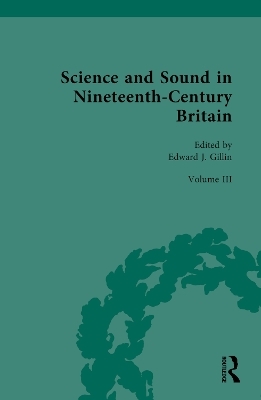
Science and Sound in Nineteenth-Century Britain
Routledge (Verlag)
978-1-032-50080-5 (ISBN)
Science and Sound in Nineteenth-Century Britain is a four-volume set of primary sources which seeks to define our historical understanding of the relationship between British scientific knowledge and sound between 1815 and 1900. In the context of rapid urbanization and industrialization, as well as a growing overseas empire, Britain was home to a rich scientific culture in which the ear was as valuable an organ as the eye for examining nature. Experiments on how sound behaved informed new understandings of how a diverse array of natural phenomena operated, notably those of heat, light, and electro-magnetism. In nineteenth-century Britain, sound was not just a phenomenon to be studied, but central to the practice of science itself and broader understandings over nature and the universe. This collection, accompanied by extensive editorial commentary, will be of great interest to students and scholars of the History of Science.
Dr Edward J. Gillin is Lecturer in the History of Building Sciences and Technology at the Bartlett School of Sustainable Construction in University College London. A cultural historian of nineteenth-century Britain, he specialises in questions of science, technology, and architecture, and how these relate to broader histories of society, politics, and religion.
Volume Three
Acknowledgements
Chronology
Introduction
John Goldingham, "Experiments for Ascertaining the Velocity of Sound, at Madras in the East Indies", Philosophical Transactions of the Royal Society, 1823, (London, England), p. 183.
Gerard Moll, "On Captain Parry’s and Lieutenant Foster’s Experiments on the Velocity of Sound", Philosophical Transactions of the Royal Society, 1828 (London, England), pp. 97-104.
John Ross, Narrative of a Second Voyage in Search of a North-West Passage, and of a Residence in the Arctic Regions, during the Years 1829, 1830, 1831, 1832, 1833, Vol. 1, (A.D. Wahlen: Brussels, 1835), pp. 197-198.
Piazzi Smyth, "On the Methods Adopted to Secure Extreme Accuracy in the Edinburgh Castle Time-Gun Signal", Transactions of the Royal Scottish Society of Arts, Vol. VI, 1864 (Edinburgh, Scotland), pp. 136-152.
E. J. Stone, "An Experimental Determination of the Velocity of Sound", Philosophical Transactions of the Royal Society, 1871, (London, England), pp. 1-6.
John Tyndall, "On the Atmosphere as a Vehicle of Sound", Philosophical Transactions of the Royal Society, Vol. 164, 1875, (London, England), pp. 183-244.
Benjamin Wyatt, Observations on the Design for the Theatre Royal, Drury Lane, as Executed in the Year 1812: Accompanied by Plans, Elevation, & Sections, of the Same (J. Taylor: London, 1813), pp. 1-55.
John Blackburn, "Description of a Sounding Board in Attercliffe Church", Philosophical Transactions of the Royal Society, 1828, (London, England), pp. 361-363.
John Scott Russell, "Elementary Considerations of Some Principles in the Construction of Buildings Designed to Accommodate Spectators and Auditors", The Edinburgh New Philosophical Journal, Vol. 27 (Apr.-Oct., 1839), pp. 131-136.
David Boswell Reid, Illustrations of the Theory and Practice of Ventilation, with Remarks on Warming, Exclusive Lighting, and the Communication of Sound (London: Longman, Brown, Green & Longmans, 1844), pp. 310-328.
Thomas Roger Smith, A Rudimentary Treatise on The Acoustics of Public Buildings; or, the Principles of the Science of Sound Applied to the Purposes of the Architect and Builder (London: John Weale, 1861), pp. 1-160.
(Anon.), "An Imperial Pitchfork", The Spectator, 28 Aug., 1858, (London, England), pp. 910-911.
(Anon.), "English Committee on Musical Pitch", The Spectator, 18 Jun., 1859, (London, England), p. 639-640.
John Herschel, "Uniform Musical Pitch", Leeds Mercury, (Leeds, England) 2 Aug., 1859; Issue 6985.
Uniform Musical Pitch. Minutes of a Meeting of Musicians, Amateurs, and others Interested in Music, Held at the House of the Society of Arts, when the Report of the Committee Appointed by the Council of the Society was Received and Adopted, (Royal Society for the Encouragement of Arts, Manufactures, and Commerce: 1860), published in "Uniform Musical Pitch", The Journal of the Society of Arts, Vol. 8, No. 417, (16 Nov., 1860), pp. 1-8.
Augustus De Morgan, "On the Beats of Imperfect Consonances", Transactions of the Cambridge Philosophical Society, Vol. 10, (1864), pp. 129-145.
Henry C. Lunn, "Musical Pitch", The Musical Times, and Singing Class Circular, Vol. 13, No. 312, (1 Feb., 1869), pp. 663-665.
(Anon.), "Orchestral Tuning", The Musical Standard, 26th June, 1875, (London, England), pp. 409-410.
Alexander J. Ellis, The History of Musical Pitch (London: W. Tounce, 1880), pp. 8-54.
John Herschel, "On Musical Scales", The Quarterly Journal of Science, No. XIX, July 1868, (London, England), pp. 338-352.
William Pole, "Explanation of the Musical Scale and its Component Intervals", in F. A. Gore Ouseley, A Treatise on Harmony, (Clarendon Press: Oxford, 1868), pp. 259-263.
Bibliography
Index
| Erscheinungsdatum | 28.12.2023 |
|---|---|
| Reihe/Serie | Nineteenth-Century Science, Technology and Medicine: Sources and Documents |
| Zusatzinfo | 39 Halftones, black and white |
| Verlagsort | London |
| Sprache | englisch |
| Maße | 156 x 234 mm |
| Gewicht | 1300 g |
| Themenwelt | Geschichte ► Allgemeine Geschichte ► Neuzeit (bis 1918) |
| Geisteswissenschaften ► Geschichte ► Regional- / Ländergeschichte | |
| Naturwissenschaften ► Physik / Astronomie ► Mechanik | |
| ISBN-10 | 1-032-50080-8 / 1032500808 |
| ISBN-13 | 978-1-032-50080-5 / 9781032500805 |
| Zustand | Neuware |
| Haben Sie eine Frage zum Produkt? |
aus dem Bereich


